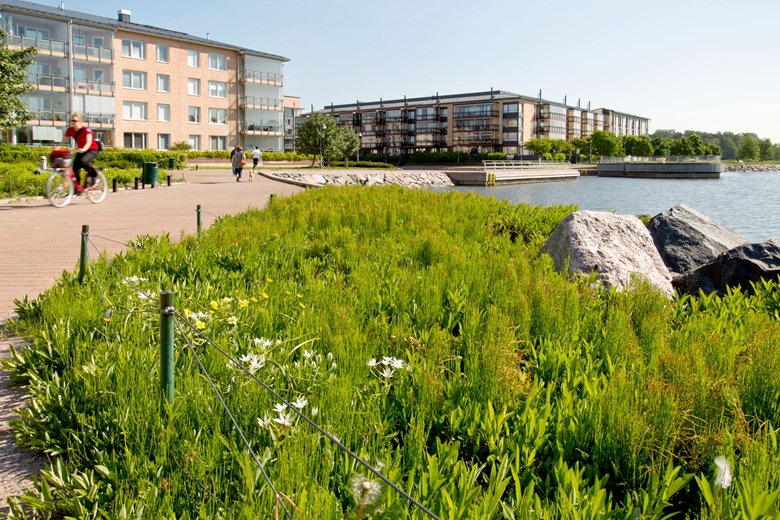Adaptation

The effects of climate change are already visible in the Helsinki metropolitan area. Heat waves have become more common and the duration of the snow cover during winters has decreased. The number of floods is expected to rise with the rising sea levels and increased precipitation.
Adaptation to climate change means tools and methods that can be used to prepare for the effects of climate change and reduce the vulnerability of society and the environment to them. Global warming causes changes in the occurrence of extreme weather events and changes conditions, directly and indirectly, over a longer period of time. Adaptation measures reduce the damage caused by these changes and promote the functioning of people, societal functions and the environment.
Adaptation planning begins with identifying climate risks and assessing vulnerabilities. A review compiling information on the effects of climate change was prepared for the Helsinki metropolitan area in 2023 based on the sixth assessment report of the Intergovernmental Panel on Climate Change (IPCC).
Adapting to climate change requires cooperation between all fields of activity in cities. The changing climate and its impacts must be taken into account in urban planning and construction, as well as in the development of social and health care services. Green infrastructure plays an important role in climate resilience of communities: they help with stormwater management and heat protection.
Steering and monitoring of climate change adaptation in the Helsinki metropolitan area
The Helsinki Metropolitan Area Climate Change Adaptation Strategy was developed in 2012 and it included policies for the period 2012-2020. The aim of the policies was to advance metropolitan area's adaptation to climate change and reduce vulnerability to extreme weather events. The strategy focused especially on enhancing the adaptation of built and urban environment to the changing climate.
The vision of the Helsinki Metropolitan Area Climate Change Adaptation Strategy was climate-proof city – the future is built now. The strategy set out the following starting points and policies for adaptation that still well match metropolitan area cities' objectives in the adaptation planning:
- Climate change mitigation is of primary importance in the region. Adapting to and preparing for the impacts of climate change is also necessary. Mitigation and adaptation measures must be coordinated.
- Climate change adaptation is taken as a key starting point in municipal planning, building regulation and guidance and the development of technical networks.
- The Helsinki metropolitan area is a forerunner in climate change adaptation.
- The public sector takes the initiative in building cooperation with interest groups and strengthening the sharing of climate-related expertise between organisations.
- The cities and municipal authorities share information about good practices in adapting to climate change.
- Functional risks caused by climate change are taken into account in the preparedness strategies of the cities.
- The public sector promotes research into adaptation to supplement the body of knowledge.
HSY has monitored almost yearly the implementation of the adaptation strategy. Information on the measures taken by the cities, HSY and HSL Helsinki Region Transport to promote adaptation to the changing climate and to prepare for extreme weather events has been compiled in the monitoring reports.
The strategy term ended in 2020, and an independent evaluation of the strategy was conducted in the spring 2021. The evaluation emphasised the effectiveness of the strategy in the adaptation of the metropolitan area. The evaluation report (available only in Finnish) concluded that the role of the strategy in bringing up and integrating adaptation questions in the cities' action planning is not overly clear. However, the strategy has helped advance the adaptation work especially in the beginning of the strategy term when its perspectives were new. The strategy is thus seen to have acted as a starting point in developing adaptation work in cities. Moreover, it was found that adaptation work has significantly gone forward in the areas of land use planning and town planning, whereas the social and health care sector should be better engaged in adaptation work in the future. The strategy was also regarded particularly important in strengthening cooperation between cities.
The cities in the Helsinki metropolitan area are involved in the Covenant of Mayors for Climate & Energy, which requires the preparation of a sustainable energy and climate action plan. The action plan also includes a vulnerability assessment and the definition of climate change adaptation measures. Therefore, there is no longer need for a metropolitan-wide adaptation strategy.
Adaptation indicators
Adaptation indicators have been developed for the Helsinki metropolitan area to understand the need for adaptation and the effectiveness of adaptation measures. The indicators are subdivided according to the European Environment Agency (EEA) into
- hazard/weather,
- exposure,
- adaptability and
- vulnerability composite indicators.
The EEA classification also includes a fifth category, i.e. indicators of sensitivity or vulnerability, but these have not yet been specifically defined for the Helsinki metropolitan area.
The adaptation indicators are developed and supplemented according to monitoring needs. Some of the indicators can be updated more frequently, but most of them are such that changes are only visible in the longer term or monitoring data is more difficult to obtain.